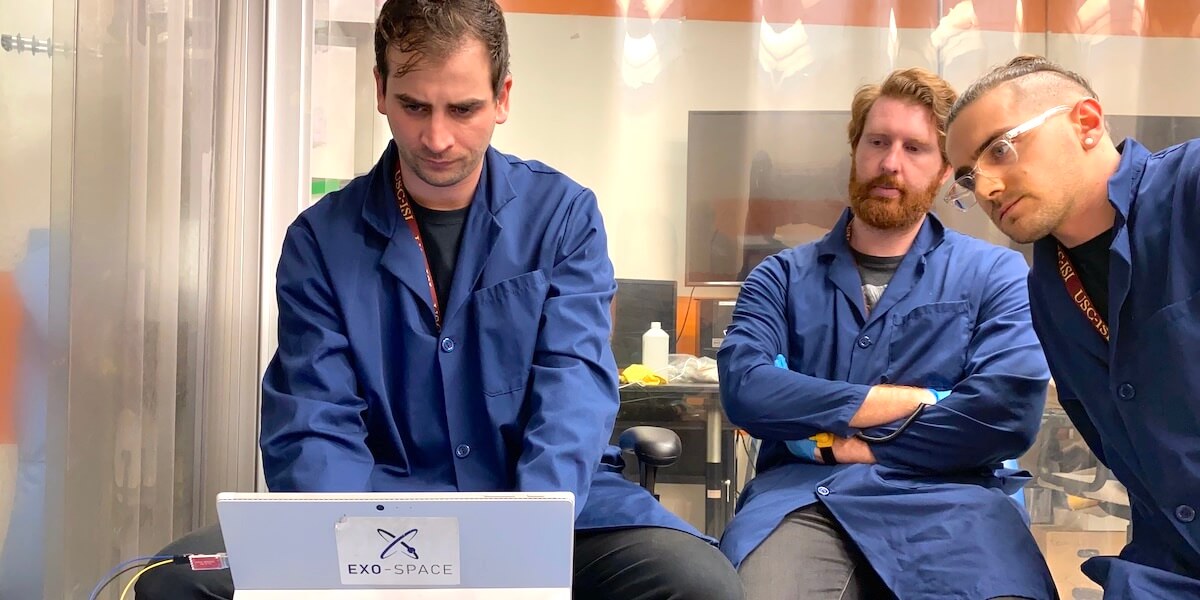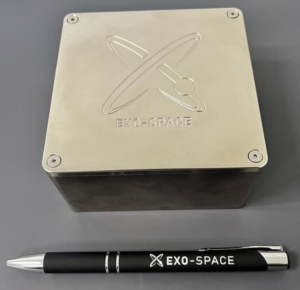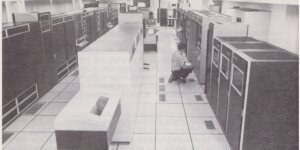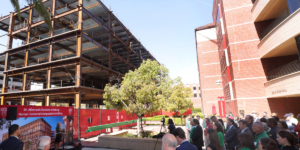
Jeremy Allam, Marcel Lariviere and Mark Lorden in the USC/ISI cleanroom
Jeremy Allam and Marcel Lariviere, recent USC Viterbi alumni, are back at USC’s Information Sciences Institute (ISI) this month. They’re not here as students, but as the co-founders of their company Exo-Space, bringing with them a piece of equipment that will vastly improve the processing and delivery of satellite images, making near real-time satellite imaging possible.

Exo-Space edge computing processor
This processor is so sensitive that it can only be worked on in a “cleanroom” – a space with a very low concentration of airborne particles. The ISI cleanroom, which uses positive pressure to keep it clean and free of contaminants, was just the place to run final checks on their device.
This is the first product from Allam and Lariviere’s company, and if all goes well it will be affixed to a satellite and launched into space in October 2023. In space, it will provide near real-time satellite images to their clients – with a delivery time orders of magnitude faster than what is currently available.
The potential applications and client list are vast for this innovative processor – near real-time imaging of forest fires; identifying the size and location of plastic in the ocean; spotting illegal fishermen off the coast of Thailand – these are just some of the current use-cases being worked on by the Exo-Space team. And they are all applications that only exist when faster satellite image processing is feasible.
It All Started at ISI (And in the Carpool Lane)
Allam and Lariviere graduated from USC Viterbi School of Engineering in 2018 with Masters Degrees in Astronautical Engineering. During their graduate studies, they both came to ISI to work a on satellite-focused projects at the Space Engineering Research Center (SERC) with Dave Barnhart, Director of SERC and Professor at the Department of Astronautical Engineering. SERC is an astronautics center located at ISI and supported by both ISI and the USC Viterbi Department of Astronautical Engineering.
Peers, friends and carpoolers, Allam and Lariviere often found themselves driving home from ISI discussing the idea of starting some type of satellite company. Allam said, “After that, in the back of my head I was always thinking, ‘Marcel and I could probably start a company together if we find the right idea.’”
Working Weekends
After receiving their master’s degrees, both went on to prestigious jobs: Allam at Jet Propulsion Lab and Lariviere at the Walt Disney Corporation as an Imagineer. But their dream of starting a satellite company together did not fall to the wayside.
Allam said, “We decided to meet every Sunday for a full day of work to try to figure out what we were going to do. We would set up in my little studio apartment; we had a chalkboard and we would just think through ideas.”
He continued, “As engineers without business backgrounds, at first, we both approached the problem with the idea that, if you could build a really cool thing, then people are going to be interested in it and want to buy it. But really, it’s the opposite. We realized that we needed to identify a much bigger market or enter into a new market that hadn’t been broken into.”
The Launch of a Satellite Company
In 2020, they found just such a market: “We came across the notion of edge computing – putting a processor local to where data is being generated and processing the data before you send it over the Internet or anywhere else.” It’s a common processing method, but not common in space.
With that, the long Sundays finally paid off and, in 2020, Allam, Lariviere, and co-founder Mark Lorden created Exo-Space to pioneer edge computing in space.
The mission of Exo-Space is to “leverage their expertise in A.I., machine vision, and satellite design to offer an edge software and hardware package that can withstand the harsh environment of space, creating edge devices that will provide data processing services for space applications, and offering services that would never have been possible.”
Edge Computing In Space
Edge computing is a method of processing data closer to where it’s being generated by increasing the proximity of networks and devices to users. It enables real-time or near-real time processing.
Allam said, “Edge computing is very common, for example, gaming companies do it all the time. They have local servers which reduces the latency of the data. So, if you’re playing online games, having a server closer to where you’re physically located means that your response time is faster and you don’t get glitches or lags. It’s the same thing for processing data anywhere else.”
A Real-Time Eye In The Sky
Exo-Space’s focus is currently computer vision – being able to use edge computing to quickly identify things on Earth from a satellite.
Traditionally, most image-collecting satellites use the same process. When they capture images, they store those raw images on the satellite, and then they downlink them to Earth. That raw data is sent to a data center to be processed, and then sent to the end user.
The Exo-Space team is able to cut out two major bottlenecks in that process by implementing edge computing. Because of this, they offer the lowest latency data possible, aiming to deliver data in 60 seconds or less, which is roughly a 100x increase in data delivery time.
Allam described the first bottleneck: “When a satellite is collecting images, it can’t downlink those images until the satellite is actually over a ground station – a massive antenna where the data can be downlinked. So, during that whole time, which can be up to 30 minutes, that data is just sitting on the satellite waiting to be sent down.”
With Exo-Space’s processor, images can be processed in the “in between time” between collecting the image and when the satellite is over a ground station.
He continued, describing the second bottleneck, “When you’re sending raw data down, the ‘data footprint’ — the size of the data — is larger because it’s unprocessed. So you have to send that through RF [radio frequency] communications to a ground station, and then send that over public Internet lines to a data center. Sending larger data down and sending it to data centers also has latency involved.”
Exo-Space processes on orbit, meaning they have a smaller data footprint to send down. They also have the advantage of sending directly to the end user because a data center is not required.
Space Entrepreneurs
Although Allam and Lariviere took the approach of looking for a new market to break into, rather than focusing on building “a really cool thing that people would be interested in” – in the end, they built a really cool thing that people are extremely interested in!
They said, “For us, starting a company was not a matter of if, but when. There are so many exciting opportunities where improvements in space technology can have a positive impact for social change and bridging that gap is what gets us out of bed in the morning.”
Dave Barnhart, the pair’s former professor and Director of SERC said, “The ability for SERC projects to train, educate and inspire students to go off and create their own companies is exactly what we hope to enable. It’s awesome to see Jeremy and Marcel’s experience on a USC satellite project translate directly into a business enterprise. While this is the first it is not the only incubation that ISI and SERC is doing to foster the second generation of space entrepreneurs!”
The Exo-Space team is looking forward to the launch of their first processor. The device, which they are doing final checks on this month in the ISI cleanroom, will be attached to a satellite that is set to launch in October of this year.
Published on March 14th, 2023
Last updated on May 16th, 2024













